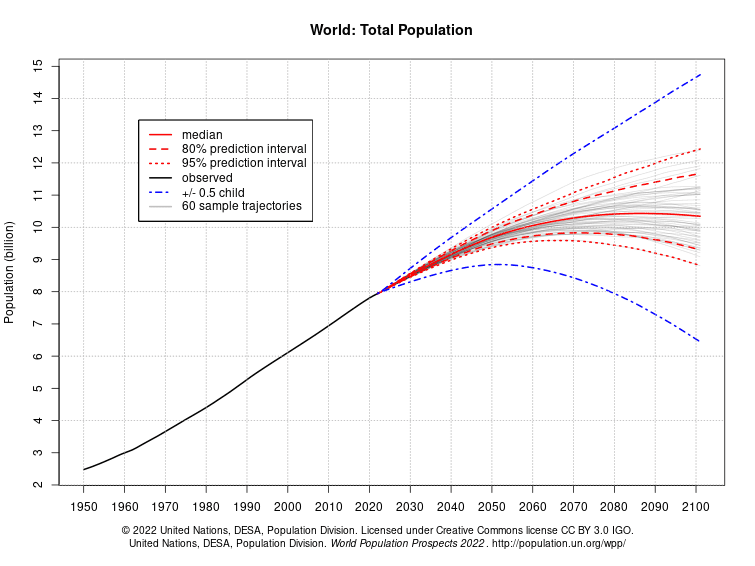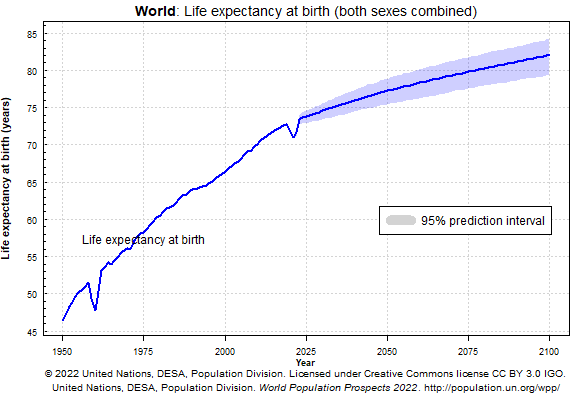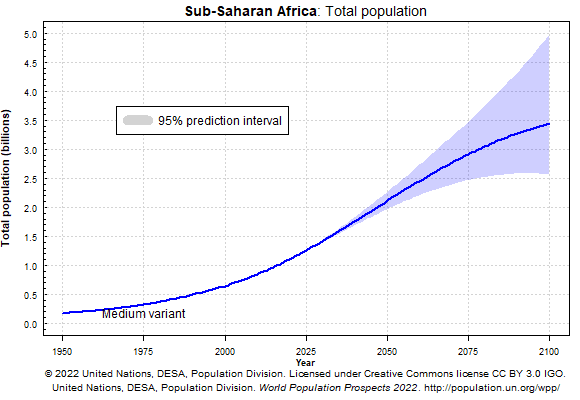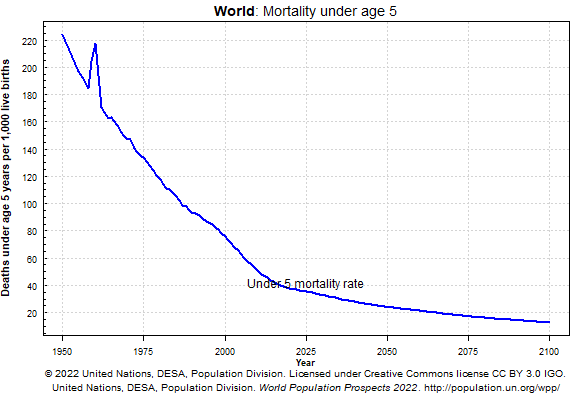On July 11, 2022 (World Population Day), the United Nations released its biennial projections for the growth of global population – World Population Prospects 2022. The report had originally been slated for release in 2021 (the last revision came out in 2019), but the COVID-19 pandemic had created delays in data collection and analysis. One of the headline findings is that our global population will reach 8 billion by November 15, 2022, sooner than previously expected.
Many of the new population projections through 2050 vary little from earlier projections. But looking ahead to the second half of this century, UN demographers are expecting population growth to continue to slow and eventually level off in the 2080s, when global population will be at about 10.4 billion.
A lot of factors go into these projections when anticipating likely fertility and mortality trends. Here are some key messages from the new World Population Prospects report.
1. A major population milestone this fall. The world’s population is projected to reach 8 billion on November 15, 2022. This represents a tripling of the world population in just 68 years.
2. New projections for this century. The latest projections by the United Nations suggest that the world’s population could grow to around 8.5 billion in 2030 and 9.7 billion in 2050; it is projected to reach a peak of around 10.4 billion people during the 2080s and to remain at that level until 2100. This is the medium scenario from the UN, which they say “embodies an optimistic vision of development. In particular, it assumes that continued progress towards gender equality and women’s empowerment will mean that as time progresses, individuals will be better able to realize their childbearing intentions. Assuming that such progress continues into the future, women will have even more social and economic opportunities and a better ability to realize their family goals.” (p.32).

3. Declining growth rates and fertility rates. In 2020, the growth rate of the global population fell to under 1 percent per year for the first time since 1950. (The high point of population growth was in 1963 when the growth rate peaked at 2.27 percent.) In 2021, the average fertility stood at 2.3 births per woman over a lifetime, down from about 5 births per woman in 1950. Global fertility is projected to decline further to 2.1 births per woman by 2050. (2.1 is considered “replacement-level” fertility.)
4. Rising life expectancy will contribute to population growth. Population growth is caused, in part, by declining levels of mortality, as reflected in increased levels of life expectancy at birth. Globally, life expectancy reached 72.8 years in 2019, an increase of almost 9 years since 1990. But life expectancy declined due to the COVID-19 pandemic over the past two years to 71.0. Further reductions in mortality are projected to result in an average longevity of around 77.2 years globally in 2050. There is still a wide gap among countries with the least developed countries 7 years behind the global average life expectancy in 2021.

5. Most of the growth in just 8 countries. More than half of the projected increase in global population up to 2050 will be concentrated in eight countries: Democratic Republic of the Congo, Egypt, Ethiopia, India, Nigeria, Pakistan, the Philippines, and the United Republic of Tanzania.
6. Population growth and the SDGs. The 46 least developed countries are among the world’s fastest-growing. Many are projected to double in population between 2022 and 2050, putting additional pressure on resources and posing challenges to the achievement of the Sustainable Development Goals (SDGs). Rapid population growth is both a cause and a consequence of slow progress in development. At the same time, achieving the SDGs, particularly those related to health, education and gender equity, is likely to lower fertility in countries with high TFRs.
7. World region with the fastest growth. Since the 1980s, sub-Saharan Africa has been the region with the fastest growing population (2.5 percent annually). Between 2022 and 2050, the population of sub-Saharan Africa is expected to almost double, surpassing 2 billion residents by the late 2040s, and growing past 3.4 billion by 2100.

8. Most populous country. And the award will soon go to … India, which is projected to surpass China as the world’s most populous country in just one year, by 2023. Each of these countries has more than 1.4 billion residents.
9. Shrinking populations for some countries. Europe’s population is projected to reach its peak in the late 2030s and then begin to decline. This is due to sustained low levels of fertility (which has been below 2 births per woman since the mid-1970s) and, in some countries, high emigration rates. China is expected to experience an absolute decline in its population as early as 2023.
10. Births to teens. Some countries, including several in sub-Saharan Africa and in Latin America and the Caribbean, continue to experience high levels of adolescent fertility, with potential adverse consequences for the health and well-being of both the young mothers and their children. In 2021, about 10 percent of births worldwide were born to mothers under 20 years old.
11. Child mortality rates falling. Globally, the under-five mortality rate fell from 92.8 deaths per 1,000 live births in 1990 to 37.1 in 2021, but there are huge disparities among regions. A child born in sub-Saharan Africa in 2021 is 20 times as likely to die before their fifth birthday as a child born in Australia and New Zealand.

12. More seniors. The share of the global population aged 65 and older is projected to rise from 10 percent in 2022 to 16 percent in 2050.
13. Different population drivers. Over the next few decades, migration will be the sole driver of population growth in high-income countries. By contrast, for the foreseeable future, population increase in low-income and lower-middle-income countries will continue to be driven by an excess of births over deaths.
14. Impacts of COVID. The COVID-19 pandemic has affected all components of population change, including fertility, mortality and migration but the extent of those effects is not yet fully understood. During 2020-2021, the UN estimates an excess mortality of nearly 15 million people due to the pandemic. Fertility was likely affected from a number of factors including postponed marriage and childbearing, and disruptions in access to sexual and reproductive health care services.
Data Visualizations of World Population
In order to make this population data more accessible to the broader public, the UN has partnered with Our World in Data to make the report easily accessible through downloadable and interactive charts, graphs and maps.
Marking 8 Billion with PopEd
Population Education will be marking the 8 Billion milestone with new teacher resources this fall, including the launch of our World of 8 Billion student video contest in September. Check back for more information!
Image credits: UN population projections chart (World: Total Population by the United Nations, DESA, Population Division); UN life expectancy chart (World: Life expectancy at birth (both sexes combined) by United Nations, DESA, Population Division); UN Sub-Saharan Africa population chart (Sub-Saharan Africa: Total population by United Nations, DESA, Population Division); UN global child mortality chart (World: Mortality under age 5 by United Nations, DESA, Population Division)




